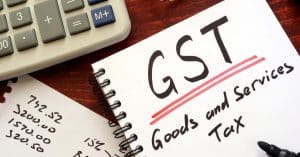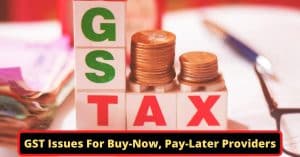GST Issues For Buy-Now, Pay-Later Providers
What Is GST?
GST is a 10% tax that is put on most goods and services in Australia. The revenue generated from GST is used to pay for public services, such as healthcare and education. There are some goods and services that are exempt from GST, including medical products and education courses.

All businesses with an annual turnover of $75,000 or more must charge GST on their products and services. However, the turnover calculation for taxi drivers is based on the number of trips made to passengers each day, regardless of the total amount of money they make. This means that even if a driver’s annual turnover is below $75,000, they still have to charge GST on their fares.
How Does GST Work?
The GST, or Goods and Services Tax, is a tax that is applied to each item at every stage of its production. This means that the tax is paid by the consumer, and it’s calculated based on the number of goods and services a country produces. The GST rate can be increased or decreased depending on how much a country wants to produce, creating more opportunities for countries with high GDP.
One important distinction between import taxes and export taxes is what makes up a GSP in an economy. When you export something, you pay taxes on the good itself as well as the value-added components (manufacturing, shipping, etc). However, when you import something, you only pay taxes on the value-added components. This difference is what allows countries to have competitive prices in international trade
How to calculate GST?
There are a few important things to remember when it comes to GST:
-GST is a tax that is charged on most goods and services in Australia
-GST is usually included in the price of an item, but sometimes it’s not. If GST isn’t already included in the price, you need to add 10% to the price
-If you’re registered for GST, you need to include GST in all your prices
The easiest way to work out how much GST needs to be added is by using the MoneySmart calculator. This calculator takes into account everything that needs to be considered when calculating GST, such as whether or not you’re registered for it and what type of sale it is. You can also use this calculator as an example for figuring out how much GST should be charged on a particular sale.
GST Issues For Buy-Now, Pay-Later Providers
The Board of Taxation released an issues paper to facilitate public consultation. The purpose of the paper is to allow for public feedback on the GST implementation, which has been in place since July 2008.
The Board asked for submissions that address the legal framework of GST. This includes submissions from buyers and sellers about their experiences with GST, as well as suggestions for improvement.

All submissions received have been acknowledged by the Board. It’s important to note that all companies registered for VAT are subject to GST rules and regulations, regardless of whether they are selling goods or services.
GST can be complex and unclear, so it’s recommended that buyer-seller meetings take place before finalizing a transaction. In order to help clarify any questions or concerns you may have, the Board offers consultation meetings free of charge.
GST tips for small businesses
Put aside the GST you collect
GST is a 10% tax put on most goods and services. This means that for every $100 you make in profit, you will need to set aside $10 to pay the government.
You can either add GST onto your prices or simply put the money aside each time it comes in.
When you’ve collected enough money to cover your GST payments, you’ll need to register for it with the Australian Tax Office (ATO) or through their online portal, the Goods and Services Tax Network (GSTN).
Your small business can claim back any charges on business supplies and expenses. So long as you keep good records of what these costs are, claiming back GST is a relatively simple process.
Digitize your business activities to make them easier
There are many benefits to digitizing your business activities, such as:
- It makes it easier to keep track of your finances.
- You can automate a lot of the processes, which saves you time.
- It’s more secure – you don’t have to worry about losing any important documents or data.
- You can access your information from anywhere in the world, as long as you have an internet connection.
- If you’re not sure where to start, there are plenty of resources available online, such as this article on small business tips for using technology.
Keep your receipts
Small businesses should keep all their receipts from purchases that are eligible for GST credits. This includes receipts from office supplies, business travel and meals, and advertising and marketing expenses. It’s important to save these documents so you can claim the Good and services tax credit on your tax return.
In addition to keeping your receipts, it’s also a good idea to subscribe to our monthly publication ‘The Charitable Purpose’. This will help you stay up-to-date with all the latest changes related to the Goods and Services Tax (GST). We respect your privacy, and you can read about it in our Privacy Policy.
How can Goods and Services Tax affect my business?
There are a few things to be aware of when it comes to GST and how it may affect your business. First of all, GST is an excise tax or Goods and Services Tax. This means that businesses need to register for the tax, but it’s not required. In addition, GST may be added to your prices, so you’ll need to pay it. Finally, GST can only be claimed back on business supplies and expenses such as advertising and marketing materials. So if you’re not sure whether or not something qualifies as a business expense, check with your accountant or the Canada Revenue Agency (CRA).
